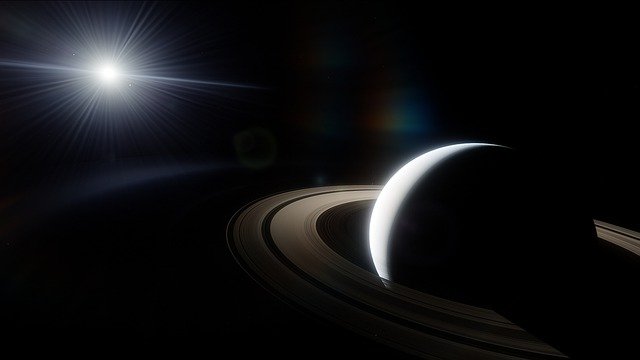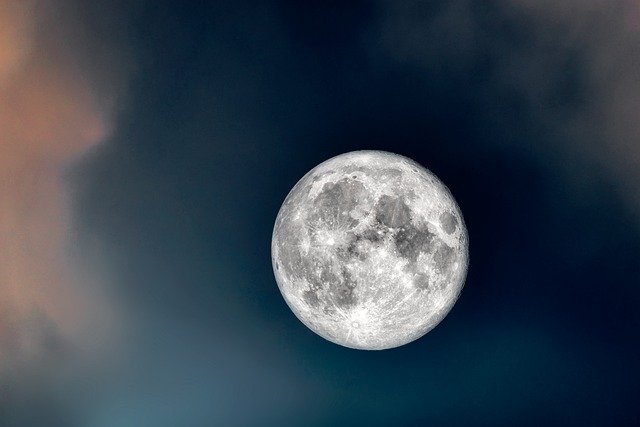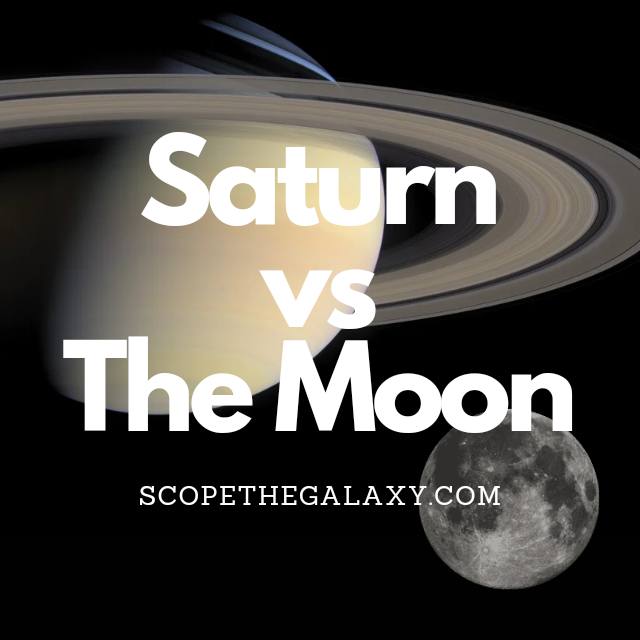*This post may contain affiliate links. This means we may make a commission if you purchase an item using one of our links*
The main differences between Saturn and the Moon is that Saturn is a yellow ringed gas giant that orbits the Sun with 82 natural satellites orbiting it whilst the Moon is a gray rocky natural satellite that orbits Earth.
There are many other differences between Saturn and the Moon so continue reading for a more thorough look at the similarities and differences between the two.
What Is The Planet Saturn?
Table of Contents

Saturn is the second largest planet in our solar system that has 7 rings surrounding its gaseous exterior. It’s also the 6th farthest planet from the Sun.
As Saturn falls under the gas giant moniker, the planet is mostly made up of gases. However, Saturn’s composition is a little different from Jupiter’s where its atmosphere is a mixture of hydrogen and ices containing elements of Ammonia.
It’s core on the other hand is comprised of a dense core of nickel and iron, which is then surrounded by rocks compressed so strongly that it allows the planets core to reach scorching hot temperatures of 11,700+ degrees Celsius.
On the other hand, It’s gaseous atmosphere is far cooler. The exterior generally sits in the extreme sub zero range where Saturn’s temperatures averages around -138 degrees Celsius.
This is generally constant throughout the yellow ringed giants day to day. In fact it’s much colder than even the coldest place on Earth, which would be Eastern Antarctic Plateau, Antarctica that hits -94 degrees Celsius, which is more than 40 degrees Celsius warmer.
Being so large (116,460km), Saturn’s gravitational pull is obviously strong. That’s why over it’s 4.5 billion years of existence, beyond its rings, this yellow gas giant has managed to accumulate 82 different moons along with other smaller interstellar debris that now orbit it.
In fact it’s largest moon Titan is literally bigger than one of the 8 planets orbiting the Sun, Mercury.
Saturn also orbits the Sun but, as the 6th farthest planet from it, it does mean a singular orbit will take it 29.4 Earth years to complete. In comparison to its axial orbit which only takes 10.7 hours, this is exponentially longer.
What Is The Moon?

The moon is the gray celestial being that orbits our Earth. It is also tidally locked to Earth meaning that we only see one side of it at any time in our sky.
It takes the moon roughly 27 days to complete an orbit around Earth, which it does in an elliptical pattern. The Moon’s axial tilt is very straight at 1.5 degrees. As a result of the tidally locked status along with the effects that Earth has on its general rotational patterns, it takes the Moon roughly 29.5 days to complete a day.
In regards to its temperature, it fluctuates where it can be really hot at 127 degrees Celsius when the Sun is shining on it and to -173 degrees in areas where the Sun does not strike it. It’s core on the other hand is far hotter ranging between 1,327 to 1,427 degrees Celsius.
This is as a result of the lunar entity’s extremely thin to practically non-existent atmosphere, which not only results in these massive temperature shifts but, is also the reason why it has over 100,000 craters on its surface.
Speaking of the Moon’s surface, the entity is mostly made of rocks, iron, magnesium just like most of the other moons and terrestrial based planets in our solar system.
It is among the bigger moons in our solar system with a diameter of 3,474.8km and a mass of 7.35 × 10^22 kg, which actually places it fifth amongst all moons in our solar system and would also make it bigger than the dwarf planet Pluto.
Despite all the advancements in technology, the last time a manned mission was made to the Moon was on the Apollo 17 way back in December 1972 and no further missions have been done since, possibly as result of the political agendas behind the numerous countries vying for opportunities that we don’t know of.
How Is Saturn And The Moon Similar?
Saturn and the Moon don’t have too many similarities but some elements are still shared, which in this case includes the below:
- Both are a spherical shape.
- Both have a hotter core.
- Both also orbit another entity.
- Both are part of the same solar system.
Differences Between Saturn And The Moon
As for their differences, they include the following:
- Saturn is the 5th farthest planet from the Sun whilst the Moon is joint 3rd with Earth. As a result it takes Saturn 29.4 years to orbit the Sun whilst the Moon does so in 365 days.
- Saturn has 7 rings surrounding it whilst the Moon has 0.
- Saturn is colder than the Moon where on average it tends to be around -138 degrees Celsius whilst the Moon fluctuates between -173 to 127 degrees Celsius.
- The Moon has no objects orbiting it whilst Saturn has 82 moons.
- The Moon orbits Earth in an elliptical pattern whilst Saturn orbits the Sun in a circular pattern.
- Saturn is a gas giant whilst the Moon is a rock based natural satellite.
- Saturn has way more mass than the Moon where it is 5.683 × 10^26 kg whilst the Moon’s mass is 7.35 × 10^22 kg.
- Saturn is pale yellow whilst the Moon is gray.
- Saturn has an axial tilt of 26.73 degrees whilst the Moon’s axial tilt is 1.5 degrees.
- A day on the Moon takes 29.5 days whilst Saturn completes a day in 10.7 hours.
Summary
Saturn is a gas giant whilst the Moon a natural satellite that orbits the Earth. Saturn by contrast has 82 of its own natural satellites and is composed of gas form as opposed to the solid rocky exterior of terrestrial entities like the Moon.
As a result it makes sense why they are so different from one another, after all one is amongst the largest entities in our solar system whilst the Moon is the fifth biggest natural satellite amongst the entities in our solar system.

